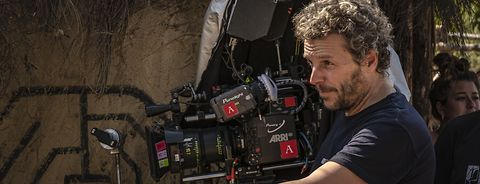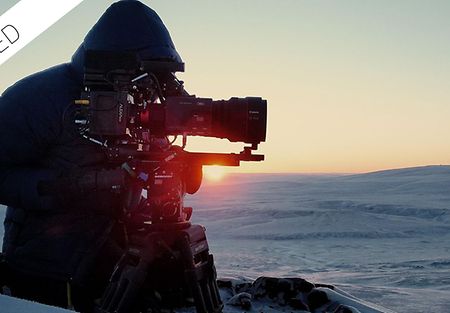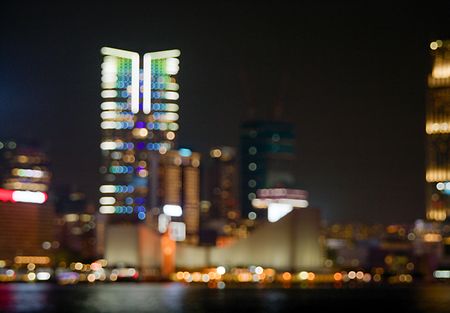Before the foundation of the Eternal City is when director Matteo Rovere chose to tell his tale with a 10-part TV series titled “Romulus.” Not for the passive viewer, this series about the origins of Rome is told entirely in archaic Latin. Like Rovere’s feature film “The First King,” based on the same subject, the series “Romulus,” produced by Sky, Cattleya, Groenlandia with ITV Studios, immerses the audience in the reality of the time.

On the set of the 10-part TV series “Romulus.”
A graduate of the Centro Sperimentale di Cinematografia with Giuseppe Rotunno in 1999, cinematographer Vladan Radovic has filmed and lit some of the most important Italian films of the 2000s, such as Bellocchio's “Il traditore” and Virzì's “La pazza gioia,” and accompanied the artistic growth of directors such as Francesco Munzi, Gianni Zanasi, Laura Bispuri, and Matteo Rovere. With the latter, he also tackled the undertaking of the TV series “Romulus,” set in the 8th century BC, shooting with ALEXA Mini and ARRI Signature Prime lenses. Radovic also chose to work with ARRI lighting for the series, specifically ARRI SkyPanels and M-Series luminaries.
ARRI had the chance to talk with cinematographer Vladan Radovic about his experience working with director Matteo Rovere on “Romulus.”
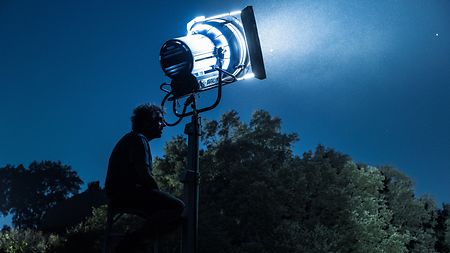
Cinematographer Vladan Radovic with the ARRI M90 lamphead.
How did you get involved in the “Romulus” project?
I had already made two shorts and a film with Matteo Rovere when he offered me to be a part of this beautiful, complicated, and ambitious project that only he could put together. In the beginning, I was a bit worried because the series is set before the foundation of Rome, a period for which we couldn't reference an existing light base, and because there were plans to shoot in the most complicated situations, such as night exteriors in the woods and villages.
But then you accepted the challenge.
I understood that I was entering a very complex but also very stimulating project, so I accepted. Matteo has great energy; he knows how to involve you one hundred percent.
How did you manage the lighting in such a unique setting?
The reference light was that of natural sources. Torches, bonfires, and fire pits were the main sources of light at night, but also during the day in the interiors. Fire was a constant presence. For daytime interiors, I always tried to use the reflection of light on natural surfaces. Today we have whitewashed houses with pale surfaces on which light is reflected, and this lighting characterizes our daytime interiors. Back then, on the other hand, there were mud walls and thatched ceilings, which were certainly warmer. So I chose to reflect the light coming in from the outside onto these surfaces to create an atmosphere that recalls that setting.

DP Radovic filming in the caves.
Did you use the work already done for the film “The First King” (original Italian title: “Il primo re”) as a reference—cinematography by Ciprì—or did you go in a different direction?
From the very beginning, Matteo was very clear. He said: “I'm happy with the photography of the film; Daniele Ciprì did a great job. But for the TV series, I want something totally different. In fact, there are different interpretations of the same era: I don't think there is the right one and the wrong one, but the one that fits the story to be told.” In “Il primo re,” Matteo and Daniele used ARRI Master Anamorphic lenses. We did several tests with three types of lenses: ARRI Master Prime, ARRI Master Anamorphic, and ARRI Signature Prime. We chose the ARRI Signature Primes and were very pleased with them. I had seen them at the MicroSalon AIC and thought they looked great, but they turned out to be even better than I expected. During the shoot, I tested them in many situations. They have a lens flare that I really like, and they offer sharpness and softness at the same time. We also used wide lenses for close-ups of 29, 25, or 21 millimeters. There wasn’t any distortion, and they gave us the option to stay very close to the characters, to breathe with them.

Radovic appreciated the “softness to the complexion” that the ARRI Signature Prime lenses captured.
Were you surprised about how suitable the lenses were for your period piece?
I am very sensitive about lenses, especially since the advent of digital, with which everything has become super sharp. That's why I like vintage lenses, which aren't perfect and allow me to break up the very high precision of the digital medium. The ARRI Signature Primes are new lenses, but they give softness to the complexion; they don't have that annoying sharpness that has to be contained with filters. In the beginning, when shooting in ProRes, there were more problems, but with the advent of ARRIRAW, the situation has improved so much. The Signature Prime lenses with the ALEXA Mini in ARRIRAW restore the naturalness and truth of the human being’s vision. I think this is really the perfection of the technical medium.
Were there any situations or technical difficulties that you resolved with ARRI?
In “Romulus,” I was able to explore the shadows and the nights in the woods and the huts. By adding very little artificial lighting, I could shoot with the light of fire pits, torches, and bonfires. I have a long history of working with ALEXA: when the era of film ended, I switched from ARRI 535 to ALEXA. I waited until the last minute, I didn’t want to make the switch until I was sure I was getting the same results, but with ARRI, we went even further. Today, we’ve gotten to a much higher, and most importantly, real sensor sensitivity. If ALEXA has a sensitivity of 3,200 ASA, they are real, usable. There are sensors with a sensitivity of 12,500 ASA that look fake, digital, noisy. I use the 2,560 ASA very often with ALEXA and have never had a problem from a digital noise standpoint.

“Super-lightweight and easy to handle,” says Radovic of the ALEXA Mini with the Signature Prime lenses.
“Romulus” is an impressive, ambitious project. How long did the filming last, and in what locations and under what conditions did you film?
We started in early June and finished in early December—about 22 weeks—with a small break in August. The locations were unique: the woods of Nettuno, the Solfatare of Pomezia, the Grotta dell'Arco of Bellegra. Most of the set constructions were done at Cinecittà World. It was very hot and very cold in locations that were difficult to reach, sometimes in the middle of the river. Still, with the ALEXA Mini, with the large format Signature Prime lenses, we could do everything because they are super-lightweight and easy to handle. Among other things, they ensure the highest quality in aerial drone shots.

DP Radovic comments: “Some locations were difficult to reach.”
What were the most challenging and then perhaps most satisfying scenes?
We shot for a month inside the caves, using the light from torches and lamps with little added artificial light. That location was difficult to get to, walking for 40 minutes through a walkway and tunnels to get to the set. In the woods, we used a lot of smoke, both during the day and at night, because it gave the possibility to light in a particular way. I often fielded the ARRI M90 lamphead with a very tall stand with no doors: it acted as a light source that often reached the camera, reproducing the effect of the sun. We also used smoke in the Battle of the River; it was beautiful.
Did you use other ARRI lights as well?
I had a great time with the ARRI M-Series lights that gave me a sun-like quality of light. Inside I used the SkyPanels for balance.
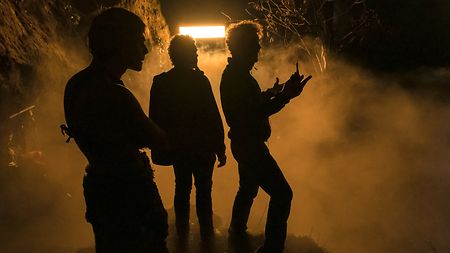
DP Radovic and crew with the ARRI SkyPanel in the background.
How did you manage the workflow?
My photography starts with the script even before we start shooting the film. I try to create the general look beforehand, with the director and colorist doing test shots, although, of course, during the shoot, everything changes. We did postproduction at InHouse with Christian Gazzi, who had prepared LUTs for us to use on set. During the shoot, I would send him the material, and then he would send us the stills he had worked on to confirm that they corresponded to the desired vision. We then did color correction of the dailies as well, which took a little time out of the shooting process but saved us a lot during postproduction.
Among extras, costumes, reconstructed sets, this project has a significant “analoge” component; it has the flavor of the great cinema of the past...
The growth of Groenlandia in recent years confirms that their approach to productions is the right way to make films: with very high-quality standards, investing money and recovering it, telling stories with the help of all departments. For this series, we did a lot of photo auditions to see how the colors of certain fabrics turned out with costume designer Valentina Taviani and with set designer Tonino Zera to check the rendering of the surfaces of the huts he had built. It was a collaborative effort that led to an important result. I hope that Italian cinema will continue to grow in this direction.

Cinematographer Vladan Radovic
Vladan Radovic has four new films on the way: Zuxin Hou’s “La ricetta italiana,” Alessandro Pondi's “Scuola di mafia,” Laura Bispuri‘s “Il paradiso del pavone,” and Massimo Donati‘s debut feature “Il diario di spezie.” “All shot with ARRI”—he emphasizes—“you don't even have to ask.”
Opening Image: DP Vladan Radovic with the ALEXA Mini and ARRI Signature Prime lenses. Camera and lighting equipment supplied by Panalight.
Photos: © Francesca Fago
